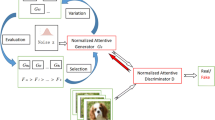Abstract
Generative Adversarial Network (GAN) is a novel class of deep generative models that has recently gained significant attention. However, the original GAN with one generator can easily get trapped into the mode collapsing problem, which could cause the generator only to produce similar images. This paper proposed a combination of GAN and an evolutionary algorithm to overcome the mode collapsing problem. In our approach, multiple generator networks are trained with the evolutionary strategy (ES), an evolution algorithm. The discriminator network distinguishes if the image comes from the real dataset or not. An additional classifier network is implemented to distinguish different generators. The mutations in the evolutionary strategy and the additional classifier network keep the diversity among generators. We term our approach the Evolution-GAN. In this paper, we conduct experiments on 2D synthetic data to verify that the Evolution-GAN overcomes the mode collapsing problem. Furthermore, experiments on MNIST datasets are implemented to compare the performance of Evolution-GAN, the original GAN, and Deep Convolutional GAN(DCGAN) and Evolutionary GAN.











Similar content being viewed by others
References
Goodfellow I et al (2014) Generative adversarial nets. Advances in neural information processing systems. NY Curran, Red Hook
Kossaifi J et al (2018) Gagan: geometry-aware generative adversarial networks. In: Proceedings of the IEEE Conference on Computer Vision and Pattern Recognition, pp 878-887
Wang X, Gupta A (2016) Generative image modeling using style and structure adversarial networks. European conference on computer vision. Springer, Cham
Nguyen-Quynh T-T, Do NT, Soo-Hyung K (2020) MLEU: multi-level embedding U-Net for fully automatic image colorization. In: Proceedings of the 4th International Conference on Machine Learning and Soft Computing
Chai L, Bau D, Lim S-N, Isola P (2020) What makes fake images detectable? Understanding properties that generalize. European conference on computer vision. Springer, Berlin, pp 103–120
Radford A, Luke M, Soumith C (2016) Unsupervised representation learning with deep convolutional generative adversarial networks. In International Conference on Learning Representations (ICLR)
Warde-Farley D, Yoshua B (2017) Improving generative adversarial networks with denoising feature matching. In International Conference on Learning Representations (ICLR)
Tim S, Ian G, Wojciech Z, Vicki C, Alec R, Xi C (2016) Improved techniques for training gans. Advances in neural information processing systems. Springer, Berlin, pp 2234–2242
Tu DN, Trung L, Hung V, Dinh P (2017) Dual discriminator generative adversarial nets. Advances in neural information processing systems (NIPS). Springer, Berlin, p 29
Tolstikhin IO et al (2017) Adagan: boosting generative models. Advances in neural information processing systems. Springer, Berlin, p 30
Wang C et al (2019) Evolutionary generative adversarial networks. IEEE Trans Evolut Comput 23(6):921–934
Heusel M et al (2017) Gans trained by a two time-scale update rule converge to a local nash equilibrium. Advances in neural information processing systems. Springer, Berlin, p 30
Salimans T et al (2016) Improved techniques for training gans. Advances in neural information processing systems. Springer, Berlin, p 29
Szegedy C et al (2015) Going deeper with convolutions. In: Proceedings of the IEEE conference on computer vision and pattern recognition
Arjovsky M, Chintala S, Bottou L (2017) Wasserstein generative adversarial networks. In: International conference on machine learning, PMLR
Author information
Authors and Affiliations
Corresponding author
Additional information
Publisher's Note
Springer Nature remains neutral with regard to jurisdictional claims in published maps and institutional affiliations.
This work was presented in part at the joint symposium of the 27th International Symposium on Artificial Life and Robotics, the 7th International Symposium on BioComplexity, and the 5th International Symposium on Swarm Behavior and Bio-Inspired Robotics (Online, January 25-27, 2022).
About this article
Cite this article
Liang, Y., Han, Z., Nie, X. et al. Improving generative adversarial network with multiple generators by evolutionary algorithms. Artif Life Robotics 27, 761–769 (2022). https://doi.org/10.1007/s10015-022-00801-7
Received:
Accepted:
Published:
Issue Date:
DOI: https://doi.org/10.1007/s10015-022-00801-7




